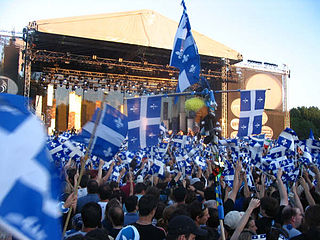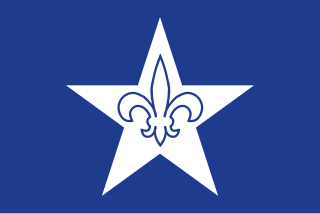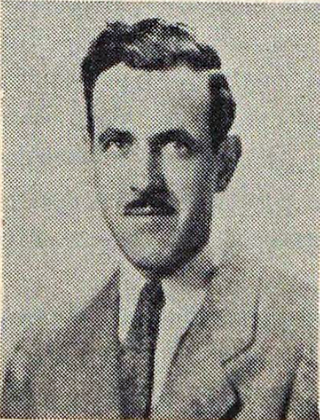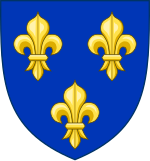
French Canadians, or Franco-Canadians, are an ethnic group who trace their ancestry to French colonists who settled in France's colony of Canada beginning in the 17th century.
The French language is spoken as a minority language in the United States. Roughly 2.1 million Americans over the age of five reported speaking the language at home in a federal 2010 estimate, making French the fourth most-spoken language in the nation behind English, Spanish, and Chinese.

Quebec nationalism or Québécois nationalism is a feeling and a political doctrine that prioritizes cultural belonging to, the defence of the interests of, and the recognition of the political legitimacy of the Québécois nation. It has been a movement and a central issue in Quebec politics since the beginning of the 19th century. Québécois nationalism has seen several political, ideological and partisan variations and incarnations over the years.
The Quebec diaspora consists of Quebec immigrants and their descendants dispersed over the North American continent and historically concentrated in the New England region of the United States, Ontario, and the Canadian Prairies. The mass emigration out of Quebec occurred in the period between 1840 and the Great Depression of the 1930s.
Little Canada is a name for any of the various communities where French Canadians congregated upon emigrating to the United States, in particular New England, in the 19th and early 20th centuries. A variant of Canadian French known as New England French is still spoken in parts of New England.

French Americans or Franco-Americans are citizens or nationals of the United States who identify themselves with having full or partial French or French-Canadian heritage, ethnicity and/or ancestral ties. They include French-Canadian Americans, whose experience and identity differ from the broader community.
Canadian Americans are American citizens or in some uses residents whose ancestry is wholly or partly Canadian, or citizens of either country who hold dual citizenship.
Anti-Quebec sentiment is a form of prejudice and discrimination which is expressed toward the government, culture, and/or the francophone people of Quebec. This prejudice must be distinguished from legitimate criticism of Quebec society or the Government of Quebec, though the question of what qualifies as legitimate criticism and mere prejudice is itself controversial. Some critics argue that allegations of Quebec bashing are sometimes used to deflect legitimate criticism of Quebec society, government, or public policies.
The history of the area comprising the U.S. state of Maine spans thousands of years, measured from the earliest human settlement, or approximately two hundred, measured from the advent of U.S. statehood in 1820. The present article will concentrate on the period of European contact and after.

Denis Vaugeois is a French-speaking author, publisher and historian from Quebec, Canada. He also served as a Member of the National Assembly (MNA) from 1976 to 1985.
Jonathan Mark Weiss is an American scholar of French literature and social science whose extensive publications include literary and theatre criticism, essays on Franco-American relations, a short story, and most recently the biography of Irène Némirovsky.
The Second Congress on the French Language in Canada was held at Université Laval in Quebec City from June 27 to July 1, 1937. The 8,000 congress members concluded the event with the formulation of 46 vows.

New England French is a variety of French spoken in the New England region of the United States. It descends from Canadian French because it originally came from French Canadians who immigrated to New England during the Grande Hémorragie.
Quebecers or Quebeckers are people associated with Quebec. The term is most often used in reference to descendants of the French settlers in Quebec and people of any ethnicity who live in the province.

The Franco-Americans, or French Americans, are a group of people of French and French-Canadian descent living in the United States. Today there are 11.8 million Franco-Americans in the US and 1.6 million Franco-Americans who speak French at home. There are also an additional 450,000 Americans who speak a French-based creole language, for example, Haitian Creole. Even though Franco-Americans are a substantial portion of the US population, they are generally less visible than other sizable ethnic groups. This is partly because of geographical dispersal, and partly because a large proportion of Franco-Americans have acculturated or assimilated.
Louis-Philippe Gagné was a French Canadian American journalist, snowshoe enthusiast, and politician. He wrote an influential and widely circulated political column in Le Messager and served as mayor of Lewiston, Maine, from 1947 to 1949.

During the late 19th and early 20th centuries Holyoke saw an influx of Franco-Americans, predominantly French-Canadians, who immigrated to Massachusetts to work in the city's growing textile and paper mills. By 1900, 1 in 3 people in Holyoke were of French-Canadian descent, and a 1913 survey of French Americans in the United States found Holyoke, along with other Massachusetts cities, to have a larger community of French or French-Canadian born residents than those of New Orleans or Chicago at that time. Initially faced with discrimination for the use of their labor by mill owners to undermine unionization, as well as for their creation of separate French institutions as part of the La Survivance movement, this demographic quickly gained representation in the city's development and civic institutions. Holyoke was at one time a cultural hub for French-Canadian Americans; the Saint-Jean-Baptiste Society of America was first organized in the city in 1899, along with a number of other institutions, including theater and drama societies from which famed vaudevillian Eva Tanguay was first discovered, and regular publications, with its largest French weekly newspaper, La Justice, published from 1904 to 1964. The city was also home to author Jacques Ducharme, whose 1943 book The Shadows of the Trees, published by Harper, was one of the first non-fiction English accounts of New England's French and French-Canadian diaspora.

Jacques Armand Ducharme was an American novelist, copy editor, and historian of French Canadian ancestry who wrote The Delusson Family, the first nationally distributed Franco American novel, and the first of the genre published in English, as well as The Shadows of the Trees, one of the first English-language history books covering the Great Migration of émigrés from Quebec to New England, and their history in that part of the United States.
Franco American literature is a body of work, in English and French, by French-Canadian American authors "who were born in New England...born in Canada, [and] spent most of their lives in New England...[, or] those who only traveled through New England and wrote of their experiences." "Franco-American literature" however, as a term, has also been characterized by novels written by the Great Lakes Region diaspora as well. In a broader sense the term is also used as a handle for those writers of Cajun or French descent, outside of the Quebec émigré literary tradition.
Camille Lessard-Bissonette, 1883–1970, pen name Liane, was a Canadian-American suffragist and writer, who contributed to Le Messager from 1906 to 1938.









